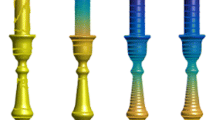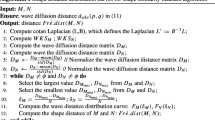Abstract
Measuring the dissimilarity between non-rigid objects is a challenging problem in 3D shape retrieval. One potential solution is to construct the models’ 3D canonical forms (i.e., isometry-invariant representations in 3D Euclidean space) on which any rigid shape matching algorithm can be applied. However, existing methods, which are typically based on embedding procedures, result in greatly distorted canonical forms, and thus could not provide satisfactory performance to distinguish non-rigid models.
In this paper, we present a feature-preserved canonical form for non-rigid 3D watertight meshes. The basic idea is to naturally deform original models against corresponding initial canonical forms calculated by Multidimensional Scaling (MDS). Specifically, objects are first segmented into near-rigid subparts, and then, through properly-designed rotations and translations, original subparts are transformed into poses that correspond well with their positions and directions on MDS canonical forms. Final results are obtained by solving nonlinear minimization problems for optimal alignments and smoothing boundaries between subparts. Experiments on two non-rigid 3D shape benchmarks not only clearly verify the advantages of our algorithm against existing approaches, but also demonstrate that, with the help of the proposed canonical form, we can obtain significantly better retrieval accuracy compared to the state of the art.















Similar content being viewed by others
References
Alexa, M., Cohen-Or, D., & Levin, D. (2000). As-rigid-as-possible shape interpolation. In Proc. SIGGRAPH (pp. 157–164).
Borg, I., & Groenen, P. (1997). Modern multidimensional scaling—theory and applications. Berlin: Springer.
Bronstein, A. M., Bronstein, M. M., & Kimmel, R. (2006). Efficient computation of isometry-invariant distances between surfaces. SIAM Journal on Scientific Computing, 28(5), 1812–1836.
Bronstein, A. M., Bronstein, M. M., & Kimmel, R. (2008). Numerical geometry of non-rigid shapes. Berlin: Springer.
Bronstein, A. M., Bronstein, M. M., Kimmel, R., Mahmoudi, M., & Sapiro, G. (2010). A Gromov-Hausdorff framework with diffusion geometry for topologically-robust non-rigid shape matching. International Journal of Computer Vision, 89(2–3), 266–286.
Chen, D. Y., Tian, X. P., Shen, Y. T., & Ouhyoung, M. (2003). On visual similarity based 3D model retrieval. In Proc. Eurographics 2003 (pp. 223–232).
Chen, X., Golovinskiy, A., & Funkhouser, T. (2009). A benchmark for 3D mesh segmentation. ACM Transactions on Graphics, 28(3). doi:10.1145/1531326.1531379.
Chui, H., & Rangarajan, A. (2003). A new point matching algorithm for non-rigid registration. Computer Vision and Image Understanding, 89(2–3), 114–141.
Cox, M. A., & Cox, T. F. (1994). Multidimensional scaling. London/New York: Chapman and Hall.
Davis, T. A. (2011). Algorithm 915, SuiteSparseQR: multifrontal multithreaded rank-revealing sparse QR factorization. ACM Transactions on Mathematical Software, 38(1). doi:10.1145/2049662.2049670.
Elad, A., & Kimmel, R. (2003). On bending invariant signatures for surface. IEEE Transactions on Pattern Analysis and Machine Intelligence, 25(10), 1285–1295.
Faloutsos, C., & Lin, K. D. (1995). A fast algorithm for indexing, data-mining and visualisation of traditional and multimedia datasets. In Proc. ACM SIGMOD (pp. 163–174).
Funkhouser, T., & Shilane, P. (2006). Partial matching of 3D shapes with priority-driven search. In Proc. symposium on geometry processing (SGP’06) (pp. 131–142).
Gal, R., Shamir, A., & Cohen-Or, D. (2007). Pose-oblivious shape signature. IEEE Transactions on Visualization and Computer Graphics, 13(2), 261–271.
Hilaga, M., Shinagawa, Y., Kohmura, T., & Kunii, T. L. (2001). Topology matching for fully automatic similarity estimation of 3D shapes. In Proc. SIGGRAPH (pp. 203–212).
Huang, Q., Adams, B., Wicke, M., & Guibas, L. J. (2008). Non-rigid registration under isometric deformations. Computer Graphics Forum, 27(5), 1449–1457.
Jain, V., & Zhang, H. (2007). A spectral approach to shape-based retrieval of articulated 3D models. Computer Aided Design, 39(5), 398–407.
Johnson, A. E., & Hebert, M. (1999). Using spin images for efficient object recognition in cluttered 3D scenes. IEEE Transactions on Pattern Analysis and Machine Intelligence, 21(5), 433–449.
Kazhdan, M., Funkhouser, T., & Rusinkiewicz, S. (2003). Rotation invariant spherical harmonic representation of 3D shape descriptors. In Proc. symposium on geometry processing (SGP’03) (pp. 156–164).
Lai, Y., Hu, S., Martin, R. R., & Rosin, P. L. (2008). Fast mesh segmentation using random walks. In Proc. SPM’08 (pp. 183–191).
Lian, Z., & Godil, A. (2011). A feature-preserved canonical form for 3D meshes. In Proc. international conference on 3D imaging, modeling, processing, visualization and transmission (3DIMPVT’11) (pp. 116–123).
Lian, Z., Godil, A., & Sun, X. (2010a). Visual similarity based 3D shape retrieval using bag-of-features. In Proc. shape modeling international (SMI’10) (pp. 25–36).
Lian, Z., Godil, A., Sun, X., & Zhang, H. (2010b). Non-rigid 3D shape retrieval using multidimensional scaling and bag-of-features. In Proc. international conference on image processing (ICIP 2010) (pp. 3181–3184).
Lian, Z., Rosin, P. L., & Sun, X. (2010c). Rectilinearity of 3D meshes. International Journal of Computer Vision, 89(2–3), 130–151.
Liu, Y., Zha, H., & Qin, H. (2006). Shape topics: a compact representation and new algorithms for 3D partial shape retrieval. In Proc. IEEE conference on computer vision and pattern recognition (CVPR’06) (pp. 2025–2032).
Lowe, D. G. (2004). Distinctive image features from scale-invariant keypoints. International Journal of Computer Vision, 60(2), 91–110.
Mahmoudi, M., & Sapiro, G. (2009). Three-dimensional point cloud recognition via distributions of geometric distances. Graphical Models, 71(1), 22–31.
Mateus, D., Cuzzolin, F., Horaud, R., & Boyer, E. (2007). Articulated shape matching using locally linear embedding and orthogonal alignment. In Proc. international conference on computer vision (ICCV’07) (pp. 1–8).
Memoli, F. (2007). On the use of Gromov-Hausdorff distances for shape comparison. In Proc. SPG’07 (pp. 81–90).
Memoli, F., & Sapiro, G. (2005). A theoretical and computational framework for isometry invariant recognition of point cloud data. Foundations of Computational Mathematics, 5(3), 313–347.
Morris, D. (2006). Voxelizer: floodfilling and distance map generation for 3D surfaces. http://techhouseorg/~dmorris/projects/voxelizer/.
Ohbuchi, R., Osada, K., Furuya, T., & Banno, T. (2008). Salient local visual features for shape-based 3D model retrieval. In Proc. shape modeling international (SMI’08) (pp. 93–102).
Osada, R., Funkhouser, T., Chazelle, B., & Dobkin, D. (2002). Shape distributions. ACM Transactions on Graphics, 21(4), 807–832.
Ovsjanikov, M., Bronstein, A. M., Bronstein, M. M., & Guibas, L. (2009). Shape google: a computer vision approach to isometry invariant shape retrieval. In Proc. NORDIA’09 (pp. 320–327).
Philipp-Foliguet, S., Jordan, M., Najman, L., & Cousty, J. (2011). Artwork 3D model database indexing and classification. Pattern Recognition, 44(3), 588–597.
Reuter, M., Wolter, F. E., & Peinecke, N. (2005). Laplace-spectra as fingerprints for shape matching. In Proc. SPM’05 (pp. 101–106).
Rustamov, R. M. (2007). Laplace-Beltrami eigenfunctions for deformation invariant shape representation. In Proc. symposium on geometry processing (SGP’07) (pp. 225–233).
Shilane, P., Min, P., Kazhdan, M., & Funkhouser, T. (2004). The Princeton shape benchmark. In Proc. shape modeling international (SMI’04) (pp. 167–178).
Siddiqi, K., Zhang, J., Macrini, D., Shokoufandeh, A., Bouix, S., & Dickinson, S. (2008). Retrieving articulated 3D models using medial surfaces. Machine Vision and Applications, 19(4), 261–275.
Sumner, R. W., & Popovic, J. (2004). Deformation transfer for triangle meshes. In Proc. SIGGRAPH (pp. 399–405).
Sun, J., Ovsjanikov, M., & Guibas, L. (2009). A concise and provably informative multi-scale signature based on heat diffusion. In Proc. symposium on geometry processing (SGP’09) (pp. 1383–1392).
Sundar, H., Silver, D., Gagvani, N., & Dickinson, S. (2003). Skeleton based shape matching and retrieval. In Proc. shape modeling international (SMI’03) (pp. 130–139).
Tam, G., & Lau, R. (2007). Deformable model retrieval based on topological and geometric signatures. IEEE Transactions on Visualization and Computer Graphics, 13(3), 470–482.
Tangelder, J. W., & Veltkamp, R. C. (2008). A survey of content based 3D shape retrieval methods. Multimedia Tools and Applications, 39(3), 441–471.
Toldo, R., Castellani, U., & Fusiello, A. (2009). Visual vocabulary signature for 3D object retrieval and partial matching. In Proc. Eurographics workshop on 3D object retrieval (3DOR’09) (pp. 21–28).
Wang, X., Liu, Y., & Zha, H. (2010). Intrinsic spin images: a subspace decomposition approach to understanding 3D deformable shapes. In Proc. international symposium on 3D data processing, visualization and transmission (3DPVT’10) (pp. 17–20).
Wuhrer, S., Azouz, Z. B., & Shu, C. (2010). Posture invariant surface description and feature extraction. In Proc. IEEE conference on computer vision and pattern recognition (CVPR’10) (pp. 374–381).
Zunic, J., & Rosin, P. L. (2004). A new convexity measure for polygons. IEEE Transactions on Pattern Analysis and Machine Intelligence, 26(7), 923–934.
Acknowledgements
This work has been supported by China Postdoctoral Science Foundation (Grant No.: 2012M510274), the SIMA program and the Shape Metrology IMS. We would like to thank the anonymous reviewers for their constructive comments, and Xu-Lei Wang for providing his results that have been compared in this paper.
Author information
Authors and Affiliations
Corresponding author
Rights and permissions
About this article
Cite this article
Lian, Z., Godil, A. & Xiao, J. Feature-Preserved 3D Canonical Form. Int J Comput Vis 102, 221–238 (2013). https://doi.org/10.1007/s11263-012-0548-1
Received:
Accepted:
Published:
Issue Date:
DOI: https://doi.org/10.1007/s11263-012-0548-1




